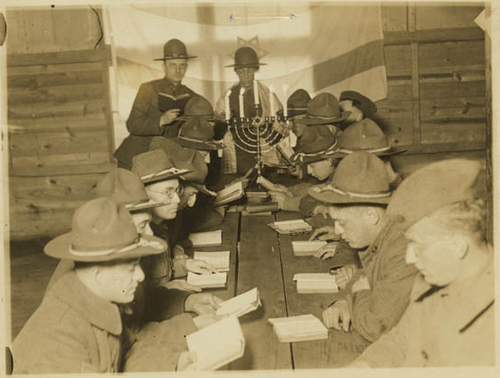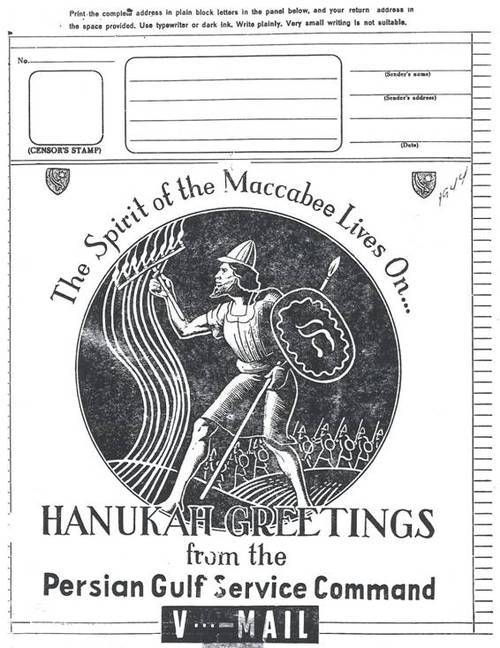by David P. Rosenberg, Senior Reference Librarian – Collections, Center for Jewish History

Above image: Hanukkah services for soldiers, circa 1917. National Jewish Welfare Board Records. c/o American Jewish Historical Society.
Quizzes
Prakim, a 1953 monthly program manual for synagogue activity, was published by the Union of Orthodox Jewish Congregations of America. Before Hanukkah questions, it has a passage on “The observance and Meaning of Hanukah,” stating:
Not in twenty centuries has Hanukah been so important a festival as it has become in our own days. No less than Jews in the past, we today read in the little lights the story of eternal Israel. We understand a little better, perhaps, what it means to enjoy liberty and to have heroes and heroines.
We also realize what it means to have Hellenists. Today we call them assimilationists—Jews who do not care whether the holidays and customs are observed, whether the Hebrew language, the Bible and Jewish history are studies, whether Palestine is rebuilt, whether every Jewish community is well organized, whether, in fact, the Jewish people and the Jewish religion survive or not. Hanukah, each year, reminds us of the fight between the Hasidim and Hellenists of old and inspires us to wage a peaceful battle against assimilation.
It continues with a “Hanukah Quizz”: Why did our great-grandfathers consider the miracle of the oil as the chief reason for celebrating Hanukah? Why do we consider the struggle for independence the chief reason? What problem faced the Jews in Maccabean times which face us American Jews today?”
It gives the responses: “In past generations, there seemed little practical possibility to rebuild Palestine. Therefore, the miracle of the jar of oil, symbolizing the miracle of Jewish survival, seemed uppermost. Today as in Maccabean times, we are faced with the problem of the survival of the Jewish people and its religion and culture.”
Out of the Archives
An item from the ASF archives, Hanukkah: the feast of lights contains history, poetry, plays, riddles, synagogue music with excerpts from the Apocrypha, the Talmud, and the Prayerbook.
Sound Recording
The ASF Besso collection also has a digitized recording of songs most likely sung in Ladino: “Sephardic ballads and popular songs.”
Craft
One loose sheet of unknown provenance filed with the other program manuals in the National Jewish Welfare Board collection suggests carving a Dreidel in four quarters of a branch or broomstick, then binding it together and pouring melded lead into the file and cleaning up the rough edges with a file. A more recent publication from the collections, The Hanukkah Book by Marilyn Burns, has plans for creating a stuffed dreidel that “won’t spin very well, but it’s nice and squeezey.”
Recipe
Sephardic holiday cooking:recipes and traditions has two particularly interesting recipes. The first is for “Yebra” Meat-Stuffed Grape Leaves. It suggests seasoning the stuffing – ground chuck with rice is suggested – with simply salt, cinnamon and allspice. Mogados De Susam (sesame candy) which are “far superior to the store -bought varieties” can be made with sesame seeds, flour, blanched almonds, honey, sugar, water and lemon juice.
Victory Mail
Like many of the newspapers preserved here at the Center for Jewish history, mail was microfilmed during WWII. It was called V-mail, short for Victory mail. Reproducing the full-size mail after it was shipped saved a significant amount of cargo space and fuel. It also deterred covert communications as invisible ink or micro-printing would not be reproduced. This 1944 V-mail form has space for the censor’s stamp as well as the attractive design.

